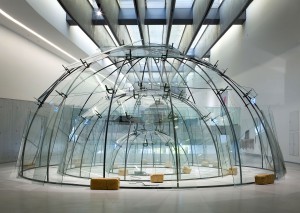Carlo Scarpa e il Giappone
#CarloScarpaeilGiappone
Full bio
Carlo Scarpa
Architect, artist and designer, Carlo Scarpa (Venice, 1906 – Sendai, Japan, 1978) is considered to be one of the most interesting figures of 20th century architecture. Educated in Venice, where he earned his diploma in Architectural Design from the Reale Accademia di Belle Arti in 1926, he began his teaching career at the IUAV, an…
Scarpa, Carlo
Architect, artist and designer, Carlo Scarpa (Venice, 1906 – Sendai, Japan, 1978) is considered to be one of the most interesting figures of 20th century architecture. Educated in Venice, where he earned his diploma in Architectural Design from the Reale Accademia di Belle Arti in 1926, he began his teaching career at the IUAV, an activity that he continued until 1977. Artistic consultant to the Società vetraria muranese, run by Paolo Venini for many years, he was later nominated its artistic director from 1934 to 1947.
The Paul Klee exhibition, shown at the Venice Biennale in 1948, marked the beginning of a collaboration that would last his entire life. In the Giardini di Castello he designed the Ticket Office (1952), the Venezuela Pavilion (1954-56) and the exhibition held in the Italian Pavilion for the XXVII Biennale in 1952. Of his numerous museum renovations we mention here the Correr Museum in Venice and the Palazzo Abatellis in Palermo (1953), the addition to the Canova Sculpture Museum in Possagno (1955-57), the addition to the Castelvecchio Museum in Verona (1957-64, 1973), the restoration of the Library at the Palazzo Querini Stampalia in Venice (1961-63) and the design of the Picasso Museum in Paris (1976). His smaller residential projects, including the Villa Guarnieri on the Venice Lido (1948), Villa Zoppas in Cornegliano (1957) and The Brion Chapel in San Vito di Altivole, Treviso, built between 1970 and 1975 represent a synthesis of the values of his work. His museum work earned him the Premio Olivetti in 1956, followed by other important the Premio della Presidenza della Repubblica per l’architettura (1967) and nominations to the Royal British Institute of Design (1970) and the Accademia di San Luca in Rome (1976).
His work has been presented in Italy and abroad in personal exhibitions: the Museum of Modern Art in New York (1966), the Venice Biennale (1968) and the Heinz Gallery in London, later transferred to Vicenza and Paris between 1974 and 1975 and, finally, Madrid in 1978.
Scarpa died in a car accident in Sendai, Japan in 1978. He was a awarded a posthumous honoris causa degree in Architecture, ending the debate regarding the legitimacy of his work as an architect.
Essential Bibliography
B. Alberini, S.Bagnoli, Scarpa. L’architettura nel dettaglio, Milano 1988
G. Beltramini, K. Forster, P. Marini (a cura di), Carlo Scarpa. Mostre e musei 1944-1976. Case e paesaggi 1972-1978, Milano 2000
F. Dal Co, G. Mazzariol (a cura di), Carlo Scarpa 1906-1978, Milano 1984
A. Di Lieto, I disegni di Carlo Scarpa per Castelvecchio, Venezia 2006
O. Lanzarini, Carlo Scarpa. L’architetto e le arti, Venezia 2003
S. Los, Carlo Scarpa, Köln 1996
A. F. Marcianò (a cura di), Carlo Scarpa, Bologna 1984
R. Murphy, Carlo Scarpa & Castelvecchio, testi di A. Di Lieto e A. Rudi, Venezia 1992
S. Polano, Carlo Scarpa. Palazzo Abatellis: la Galleria della Sicilia 1953-54, Milano 1991
AA.VV., Carlo Scarpa Architect. Intevening with the history, Montréal 1999
E. Terenzoni (a cura di), I disegni per la Tomba Brion. Inventario, Milano 2006
V. Zanchettin, Carlo Scarpa. Il complesso monumentale Brion, Venezia 2002
G. Beltramini, I. Zannier (a cura di), Carlo Scarpa. Atlante delle Architetture, Venezia 2006
R. Codello, A. Torsello, Architetture veneziane di Carlo Scarpa, percorsi e rilievi in cinque opere
E. Valente, V. Zanchettin (a cura di), I teatri di Carlo Scarpa. Archivio e ricerca nelle collezioni del MAXXI Architettura, Milano 2010
photogallery
MAXXI in the world
CENTRO CARLO SCARPA | Treviso
22 September 2017 – 27 January 2018
CENTRO DE ARTE CONTEMPORANEO (CAC) | Quito
19 November – 31 December 2018
MUSEO ARCHIVO DE ARQUITECTURA DEL ECUADOR (MAE) | Quito
15 January – 18 April 2019





































MAXXI Architecture Archives Centre
On the occasion of the exhibition The Japanese House, , dedicated to tradition and innovation in the architecture of Japanese homes, the Archives Centre is hosting an investigation of the multiple and deep-rooted motivations that link the architect and designer Carlo Scarpa to Japan, to its architectural culture, its literature and its historical, cultural and constructional traditions.
A story composed of projects, photographs and documents, many on show for the first time.
A complex system of relationships, suggestions and studies that have over time linked Carlo Scarpa, a lover and connoisseur of the country from 1969, and Japan itself which held the architect in great esteem, in particular for his published materials.
As well looking at which projects and in which forms Japan is to be found in Scarpa’s work, light is also shed on the episodes and factors that gave rise to this interesting system of relationships: papers, the architect’s personal library, critical fortunes in Japan and travel photos.